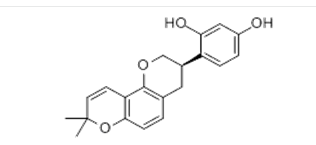Knowde Enhanced TDS
Identification & Functionality
- Chemical Family
- Ingredient Origin
- Cosmetic Ingredients Functions
- Molecular Formula
- C20H20O4
- CAS No.
- 84775-66-6
- Technologies
- Product Families
- Molecular Structure

Features & Benefits
- Benefit Claims
- Labeling Claims
- Benefits
- Skin whitening - As a natural whitening ingredient, the skin-whitening mechanism of Glabridin mainly includes: (1) inhibiting tyrosinase activity; (2) inhibiting the activity of dopachrome tautomerase (TRP-2) (3) inhibiting the activity of DHICA oxidase; (4) exerting the function of endothelin antagonist; (5) increasing the total antioxidant capacity of the skin; (6) effectively scavenging oxygen free radicals and its chain reaction. Moreover, through these synergistic effects, it effectively prevents the polymerization of 5,6-dihydroxyindole (DHI) and the production of dopachrome. Thereby Glabridin can disturb and hinder the formation and transport of melanin; and then it inhibits and reduces pigmentation so as to achieve whitening skin effect.
- Anti-inflammatory and antibacterial - The anti-inflammatory effect of Glabridin is related to its anti-oxidative activity of scavenging reactive oxygen. Glabridin can inhibit the production of NO in macrophages and the expression of inducible NO synthase. Then it can prevent the development of inflammation. Also Glabridin can inhibit the activity of staphylococcus aureus and candida albicans. It has a strong antibacterial effect, and can be used for the treatment of acne.
- Antioxidant - Glabridin has shown strong anti-free radical oxidation in the cytochrome oxidation system. It can significantly inhibit the free radicals generated in the body’s metabolism. Then it prevents the oxidation-sensitive bio-macromolecules (LDL, LDL, DNA) and cell walls from being oxidized and damaged by free radicals. As an antioxidant, Glabridin can also inhibit the production of reactive oxygen species and activation of p53; it regulates the cleavage of BCL-2 and poly ADP ribose polymerase. And it can fight against oxygenated DNA fragments of keratinocytes induced by UV; then it prevents sun-induced skin aging.
- Sunscreen - The conjugate property in the molecular structure of licorice flavonoids assures that Glabridin is characterized by strong absorption of both ultraviolet and visible light. Therefore, the sunscreen mechanism of Glabridin has the highest absorption peak for ultraviolet rays. And it effectively blocks ultraviolet rays from the skin surface after being applied to the skin. Furthermore, it also works by absorbing unstable molecules of high-energy ultraviolet rays. Then it converts the ultraviolet rays that damage the skin into harmless, low-energy and non-damaging ones.
- Characteristics
- Complete specifications, fine quality control; high purity and remarkable effect of product;
- Use high-quality Glycyrrhiza glabra as the raw material for extraction;
- Plamed has a Glycyrrhiza glabra planting base to ensure stable supply.
- Plamed develops PCR Glabridin with high bioavailability than three times that of ordinary Glabridin. It is better to be absorbed by skin, with a low price.
Applications & Uses
- Markets
- Skin Care Applications
- Sun Care Applications
- Treatment Product Applications
- Source
Glycyrrhiza glabra (Latin name: Radix Glycyrrhizae Glabrae) is a perennial herb of the Leguminosae family. It is also named licorice. It has thick roots and stems. Glycyrrhiza glabra mainly grow in ditch, roadside, river bank terraces and even arid saline soil. In China, the main producing areas of Glycyrrhiza glabra L. are Xinjiang and the northeastern provinces. Among them, Xinjiang is rich in licorice resources and good in quality, mainly distributing in Korla, Aksu and Shihezi areas; and there are both wild and artificial cultivation resources. Europe, the Mediterranean countries, Russia, Siberia and Mongolia also have licorice distribution. The roots and stems of Glycyrrhiza glabra are available for medicinal purposes. And its dried roots are mainly used in cosmetics.
Properties
- Soluble in
- Ethanol or butylene-glycol
- Physical Properties
- Typical Properties
- Microbiological Values
- Heavy Metals
| Value | Units | Test Method / Conditions | |
| Particle size (through 80 mesh) | 98 | % | - |
| Loss on drying | max. 5.00 | % | - |
| Residue on ignition | ≤1.00% | - | - |
| Value | Units | Test Method / Conditions | |
| Molecular Weight | 324.37 | g/mol | - |
| Specification (HPLC) | 98 | % | - |
| Assay (White) | 40 | % | - |
| Assay (Brown) | 40 | % | - |
| Value | Units | Test Method / Conditions | |
| Total plate count | max. 1000 | cfu/g | - |
| Yeast & mold | max. 100 | cfu/g | - |
| E. coli | Negative | - | - |
| Staphylococcus | Negative | - | - |
| Salmonella | Negative | /10g |
| Value | Units | Test Method / Conditions | |
| Heavy metals | max. 10 | ppm | - |
| Arsenic | max. 2 | ppm | - |
| Lead | max. 2 | ppm | - |
Technical Details & Test Data
- Manufacturer Process Flow Chart

Safety & Health
- Safety
- CTFA has specified Glabridin as a raw material for cosmetics;
- The plant raw materials listed in The List of Used Cosmetic Ingredient approved by the Ministry of Health of the People’s Republic of China in 2001 include Glycyrrhiza glabra.
- China has included Glabridin in The International Catalog of Chinese Cosmetic Raw Materials Standards (2010 edition) published by CAFFCI and On the Announcement of Name List of Cosmetics Raw Material issued by CFDA in 2014. There are no reports showing that is unsafe for external use.
Packaging & Availability
- Packaging
- Packed in 25kg paper drums with two plastic bags inside.
- Minimal Package - 100G
- Minimal Order Quantity - 100G
Storage & Handling
- Storage
Stored in a cool dry place and away from direct sunlight and oxidizing agents.
